Bibliometrics analysis of applied nursing personnel training in China
Ping Xu,Ming-Jin Li*,Xiang-Shu Cui*
1School of Nursing,Yanbian University,Yanji 133000,China.
Abstract Objective: To make a visual analysis of literature metrology on the training of applied nursing talents in China, to clarify the research hotspots and development trends, and to provide basic information for the education and teaching reform of applied nursing talents in China. Methods: The literature related to the training of applied nursing talents in China was retrieved from CNKI, Wanfang, Weipu database. NoteExpress was used for removing duplicates, and Bicomb2.0 was used to extract key fields and generate word matrix, which was imported into gCluto1.0 for double cluster analysis. Results: Finally, 675 articles met the inclusion and exclusion criteria, the number of articles is increasing yearly. 39 high-frequency keywords,such as practice teaching and 9 core authors such as Song Mei are extracted. The results of double cluster analysis showed that the research topics included five aspects: nursing education reform; training of applied nursing talents at different levels;quality of practical teaching; practice teaching reform and laboratory management;application-oriented nursing personnel training mode. Conclusion: The reform and practice of application-oriented nursing talents training in our country are developing continuously,and has gradually received great attention from universities, the local governments and national government departments. The research focuses on the reform of training mode of applied nursing talents at different levels, practice teaching reform, laboratory management and other aspects, which can provide a reference for the reform and practice of applied nursing talents training in China.
Keywords:applied nursing talents; visual analysis; double clustering; literature metrology
Background
With the development of economy and society and the popularization of higher education, the emergence of applied talents has well solved the problem of structural contradiction in the talent market [1]. The development of society cannot be separated from applied talents [2],and the target orientation of applied talents training marks the further maturation of higher education in China and a more reasonable layout of talents training[3]. The National Nursing Career Development Plan(2016-2020) points out that the professional quality and service capacity of China's nursing team need to be improved. Universities should train talents in a demand-oriented manner, combine with the needs of the industry, fit the requirements of local development, and cultivate applied nursing talents [4]. At present, the objective of cultivating applied nursing talents in China's nursing colleges are not clearly positioned, and the boundary between cultivation mode and research nursing talents is blurred, thus affecting the quality of cultivating high-quality applied nursing talents. Therefore, this study aims to analyze the current situation of applied nursing talent cultivation in China, explore the research hotspots, clarify its development trend, and provide basic information for carrying out education and teaching reform and practice of applied nursing talent cultivation.
Materials and methods
General information
In this study, Chinese databases such as China Knowledge Network,Wanfang, and Weipu were searched to retrieve relevant literature since the establishment of the databases until May 31, 2021. The retrieval strategies of China National Knowledge Infrastructure(Hereinafter abbreviated as “CNKI”) and Wanfang database are as follow: Subject words “Applied talents” & “Nursing” NOT “Secondary students” NOT “Secondary vocational education” NOT “Vocational students”; the retrieval strategy of VIP database is as follows: title or key words “application-oriented talents” & “nursing” NOT “Secondary students” NOT “Secondary vocational education” NOT “Vocational students”. Relevant academic dissertations, conference papers, notices and reports etc. are excluded. NoteExpress software was used to remove duplicate references among three databases, and 675 papers that met the criteria were included eventually.
Analytical methods
Word frequency analysis method. The bibliographic information co-occurrence mining system [5] Bicomb 2.0, developed by Cui Lei et al. from China Medical University was used to extract keywords from the literature included in this study, synonyms and synonyms were combined, and high-frequency words were statistically analyzed.
Double clustering. Double clustering is to cluster samples and variables in the data matrix simultaneously, realizing the simultaneous clustering of objects and attributes, and using objects and their attributes to extract their union information and discover potential local patterns [6]. In this study, the graphical clustering toolkit gCluto1.0 is used for biclustering analysis, and the clustering information is presented by visualizing hill plots and dendrograms.The shape of each hill is a Gaussian curve, and the height of the hill is proportional to the intra-class similarity; the volume of the hill is proportional to the number of objects contained in the cluster; the color of the hill is proportional to the intra-class standard deviation,with red representing low standard deviation and blue representing high standard deviation, and only the color of the peak is meaningful[7]. Using this method to analyze keywords the analysis of applied nursing talent training research in China.
Results
Analysis of annual publication volume
The number of publications was counted according to the year. The Figure 1 showed that the first paper on applied nursing personnel training appeared in 1994; few studies were conducted between 2001 and 2003; the number of publications in the decade from 2004 to 2014 showed an overall increasing trend; and the number of publications fluctuated between 2015 and 2020.

Figure 1 Annul publication volume applied nursing personnel training in China
Fund support analysis
The statistical analysis of annual fund support shows that the literature without fund support accounts for 69.78%. Although the literature without fund support is more, the overall volume of literature supported by each level of fund shows a steady increase yearly, see Figure 2 and Figure 3 for details.

Figure 2 Applied nursing talent fund support in China
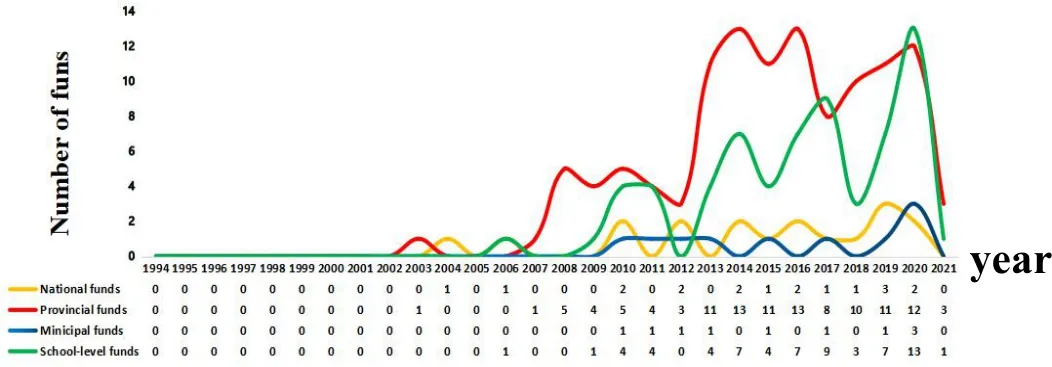
Figure 3 Number of different types funds for the training of applied nursing talents in China
Analysis of core authors
According to Price’s theory, core authorship is defined based on the formula [8].

(N: the lower limit of number of articles issued by the core authors,nmax: the number of articles issued by the most prolific author), the number of articles issued by the most prolific author in this study is 7,which is obtained by substituting the formulaN= 2.6457. After statistical analysis by Bicomb2.0 software, we got 9 core authors, and the most prolific author is Song Mei (7 articles), see Table 1 for details.
Analysis of published journals
Among the top ten journals in issuance, the first one is Health Professional Education; core journals include Nursing Research,Chinese Nursing Education and Journal of Nursing,etc.The number of core journals issued 52 articles, accounting for 25.62% of the total number of top ten journals, as shown in Figure 4.

Table 1 Number of core author publications (n= 9%)
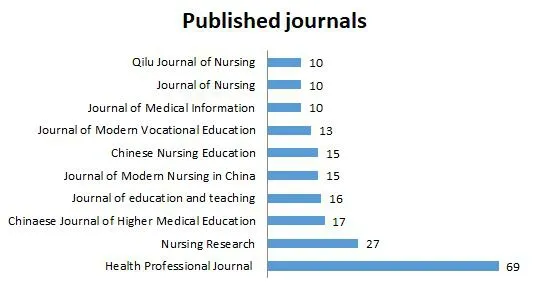
Figure 4 Distribution of the top ten journals in terms of number of articles published
High frequency subject headings
There are various ways to determine the high-frequency topic words[9]. This study use Donohue’s formula [10]
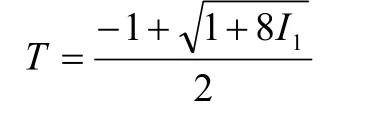
(I1is the number of keywords with a frequency of 1), and those greater than T is the high-frequency keyword, and the formula is used to calculate the number of high-frequency keywords in this study.T=13.58, the frequency of ≥14 is the high-frequency keywords of this study, which is shown in Table 2.
Bi-directional clustering of high-frequency topic words
Visualization of hills. The hill map obtained by gCluto1.0 software clustering presents hot topics, and finally 5 clusters are selected as the best clusters. As shown in Figure 5, there are five clustered hills, and the peaks of the hills of clusters 0, 3 and 4 are red, representing a smaller standard deviation of intra-class similarity and more concentrated distribution, among which the intra-class similarity of cluster 0 is the highest and the most concentrated distribution; the peaks of the hills of cluster 1 are orange, representing a lower standard deviation of intra-class similarity and a more consistent study in the literature; the peaks of cluster 2 are green, representing a more widely distributed study topic.

Figure 5 Avisual hill map of applied nursing talent development research in China
Visualizing the matrix diagram. The value of the original matrix data in the visualization matrix are replaced by colors, white represents close to zero value, as the value increases, the red color gradually deepens [7]. The matrix color blocks represent whether the topic words appear in the corresponding articles, and the black horizontal line separates the clusters [9]. The row clusters (left side) in the visualization matrix represent the clustering of high-frequency subject terms, and the corresponding subject terms are listed on the right side of matrix, and the high-frequency subject is clustered into 5 categories, see Figure 6 and Figure 7 for details.
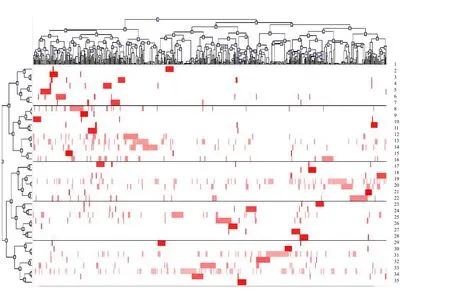
Figure 6 Visualization matrix of applied nursing talent development research in China. 1, Master’s degree in Nursing; 2, Clinical practice skills; 3, Undergraduate nursing talents; 4, Talent demand; 5, Vocational education; 6, Applied talents; 7, Education reform; 8, Talent development model; 9, Nursing talent; 10, Private universities; 11, Nursing program, 12, Undergraduate college, 13, Talent development model; 14,Application-oriented talents, 15, Bachelor of Science in Nursing; 16, Job competence; 17, Nursing program; 18, Human anatomy; 19, Classroom teaching; 20, Course construction; 21, Teaching reform; 22, Vocational nursing; 23, Course reform; 24, Nursing education research; 25, Vocational college; 26, Faculty development construction; 27, Nursing; 28, Students nursing; 29, Nursing operation skills; 30, Teaching tools; 31, Obstetrics and gynecology nursing; 32, Teaching method; 33, Practice nursing; 34, Basic nursing,; 35, Nursing lab.
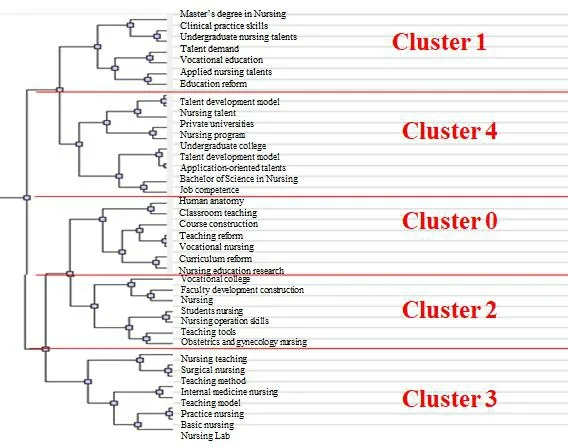
Figure 7 Clustering tree diagram of applied personnel training in China
Analysis of applied nursing talent research themes in China
Cluster 0: nursing education reform. The results of this clustering showed that the literature on nursing education reform was abundant and highly consistent in terms of research themes, as detailed in Table 2 and Figure 7. Studies in this category were mainly concerned with teaching reform, curriculum construction and reform, and classroom teaching, and were particularly prominent in higher vocational nursing. Literature 0000000159 [11] described reforms in teaching methods and instructional design of a comprehensive general nursing course for pre-practicum nursing students, which improved teamwork and communication skills; literature 0000000312 [12] analyzed the problems of teaching nursing anatomy in high school and carried out a series of reform practices such as cooperation of teaching and research departments, training of instructors at practice bases, collective lesson preparation, preparation of nursing applied anatomy laboratory, and production of special teaching specimens for nursing anatomy to make the basic course of anatomy more professionally relevant; literature 0000000628 [13] relying on the basic courses of nursing to carry out the reform of teaching mode and teaching method, to strengthen the connection between theory and practical teaching with competence as the basics, and to cultivate applied nursing talents with comprehensive development of morality, intellect, physique and beauty. Demand is the direction of reform, competence is the need of industry development [13, 14]. The integration of disciplines and curriculum is the trend of reform, and the reform of basic courses such as basic nursing and anatomy is the basic and key to improve the ability of nursing students.
Cluster 1: different levels of applied nursing talent training. The standard deviation of intra-class similarity of literature within this cluster is low, and the number of literature is high. From Table 2 and Figure 7, it can be seen that the educational reform revolves around the cultivation of applied nursing talents at different levels, including senior high school, undergraduate, and graduate levels. Literature 0000000365 [15] showed that high-simulation pre-practicum scenario simulation teaching for senior high school nursing students can effectively improve teamwork and other skills. Literature 0000000668 [16] conducted an empirical study to construct the educational objectives of nursing talents in community nursing direction in applied high school. Literature 0000000164 [17], reform proposals were put forward for cultivating applied undergraduate nursing talents from various aspects such as teaching organization form and construction of dual-teacher faculty team. High-level talents with graduate degrees are an indispensable part of China’s applied nursing talent cultivation system, and the standardized system and standards are fundamental to ensure the perfection of the system [18].At present, China’s MNS is still in its initial stage,and it is necessary to draw on mature experiences in the external context and strengthen the connection between theory and practice through reform and standardization of the system, so as to build a suitable postgraduate nursing degree cultivation system in China and cultivate high-level applied nursing talents [19].
Cluster 2: quality of practical teaching. The research themes within this cluster are more dispersed, and from Table 2 and Figure 7, it can be seen that the research theme mainly include faculty development,nursing practice teaching, and teaching methods, mainly involving clinical practice teaching. The literature 0000000165 [20] introduced the problems of insufficient teaching resources and derailment between theory and practice in teaching obstetrics and gynecology nursing, which were solved by the network experimental platform built with the help of Internet technology, but some teaching resources intellectual property issues need to be solved; literature 0000000549 [21], with the basic textbook of nursing as a reference,the reform is carried out in various aspects such as the arrangement of laboratory class hours and teaching methods, and with the help of modern technology such as virtual simulation platform,comprehensive practical training is carried out before clinical practice of nursing students, which improves nursing skills and comprehensive literacy and is well adapted to clinical nursing work, and is highly praised by practice bases and employers; literature 0000000286 [22]analyzed the current situation and problems of the practical teaching link of obstetrics and gynecology nursing, and relevant strategies to improve the quality of practical teaching, such as strengthening the construction of hardware facilities, reforming teaching methods and strengthening the construction if dual-teacher faculty were proposed.On-campus practice teaching attects the quality of practice teaching,and clinical practice teaching should not be neglected as well. At present, there are problems such as backwardness in leading teaching and unclear objectives of leading teaching in clinical practice [23].The quality of practice teaching can be improved by improving the non-power influence of teaching [24].
Cluster 3:practical teaching reform and laboratory management.
The consistency of literature within this cluster is high, but the number of literature is relatively small. Combining Table 2 and Figure 7,it can be seen that the research mainly includes teaching methods of each course, teaching mode, and laboratory construction and management. Literature 0000000308 [25], in order to change the backward status quo of nursing laboratory teaching, the nursing training room of the college and affiliated hospital were integrated to create an integrated practice base of “teaching-doing”, which helped nursing students get rid of their unfamiliarity with the clinic through clinical scenario simulation and multimedia teaching-assistance system, and effectively improved their operational skills,communication ability and adaptability. Literature 0000000186 [26],using problem-discuss-guidance (PDG) abilities, and promotes the construction of faculty and laboratory teaching materials. Literature 0000000141 [27], the anchor teaching method was used to develop nursing students’ key competencies in surgical nursing teaching with the help of Internet and multimedia technology. The construction and use of laboratories are also an important part of the practice reform,and the open management mode of not only enables nursing students to improve their practical skills, but also improves the utilization rate of laboratories [28].
Cluster 4: applied nursing talent training model. The number of literature within this cluster is similar to that of cluster 1, but the consistency of research themes is higher. Combing Table 2 and Figure 7, it can be seen that applied undergraduate nursing talents take job competency as the starting point, and there are more private and independent institutions among school types. The literature 0000000360 [29] analyzed the situation of emerging private colleges and universities, and proposed the “211” model of “2 years to consolidate the foundation, 1 year to combine with institutions and 1 year to practice outside the school” in the process of cultivating applied undergraduate nursing talents. Literature 0000000307 [30], a model of training applied undergraduate nursing talents based on job competency theory. Literature 0000000630 [31], to optimize the talent training program with market demand as the guide and foreign-related as the future, and to cultivate bilingual undergraduate nursing talents. The cultivation of applied nursing talents should be constantly innovated with the times [32]. In order to make the training program reform, optimize the training process, and improve the quality management system and guarantee system for the training of applied nursing talents, we should take into account the social development and demand, the orientation of the college, and the characteristics of the student population [33],to make the cultivation of applied nursing talents better meet the needs of society.
Discussion
Rigor and science of research methods
In this study, we retrieved the literature related to “applied nursing talents” from three databases, namely CNKI, Wanfang and Weipu, and analyzed the external and internal characteristics with the help of NoteExpress, Excel, Bicomb and gCluto, and combined the professional knowledge and opinions of the research group to merge key words. After double cluster analysis, five research themes were obtained: nursing education reform, different levels of applied nursing talents cultivation, practice teaching quality, practice teaching reform and laboratory management, and applied nursing talents cultivation mode, among which nursing education reform, different levels of applied nursing talents cultivation, practice teaching reform and laboratory management and applied nursing talents cultivation mode were the research hotspots. Among the various methods for detecting information on research frontiers, citation analysis of biclustering in bibliometrics can overcome some defects of traditional clustering methods[7].
Research hotspots analysis of applied nursing talent training in China
Nursing education reform. The main task of educational reform is to adapt and serve the development of society [34]. The balance of supply and demand and the development requirements for the nursing profession have changed with the development of the times and changes in the nursing model, etc. In order to cope with this change and meet the demand of nursing positions, universities should formulate the training objectives and revise the training programs under the guidance of the documents of the Nursing Professional Education Committee, and carry out teaching reform and curriculum reform on this basis to cultivate more high-quality nursing talents in the new era. As the homogenization of higher education in China is serious and the structural contradiction is prominent, the cultivation of talents cannot be adapted to the industrial structure.In this context,some local undergraduate colleges and universities are actively guided to transform into application-oriented colleges and universities [35].The General Office of the State Council issued “Several Opinions of the General Office of the State Council on Deepening the Integration of Industry and Education [36]. It is pointed out that we should promote the collaborative education of industry and education, improve the cultivation system of academic and application-oriented talents in higher education, and increase the proportion of application-oriented talents cultivation. In the context of education system reform, nursing majors must implement national policies, and comprehensively implement nursing education reform, from curriculum system,training objectives, talent training programs, talent training mode,etc., to promote one by one. In the context of “double first-class”construction, the Ministry of Education of China [37] pointed out that in order to improve the teaching effect and talent cultivation quality of curriculum. It is necessary for universities and teachers to carry out curriculum reform.
Cultivation of applied nursing talents at different levels. With the reform and development of nursing education in China, China has formed an education system containing three levels: specialist,undergraduate and postgraduate [38]. The applied talents have different types and levels, which can be divided into specialist level applied talents, undergraduate level applied talents and graduate level applied talents [39]. The universities at each level are responsible for different tasks. Applied talents can be divided into three types:engineering, technical and skill-based [1]. Vocational colleges mainly undertake the cultivation of skilled personnel; undergraduate colleges mainly cultivate technical talents; the main objective of cultivating applied talents at graduate level is engineering type [39]. In order to match the talent demand of the nursing industry, applied nursing talents at all levels are cultivated to add blood and strength to the development of China’s nursing career.
Practical teaching reform and laboratory management.Practicalteaching is the key link in the cultivation of application-oriented talents [40]. The abilities and qualities required for applied nursing talents need to be cultivated through practice,which involves experimental teaching, practical training teaching,clinical internship and clinical practice, and both on-campus practice and off-campus practice are very important. On-campus practice training is the foundation and guarantee of clinical internship and practicum, and the continuous reform of practice teaching is a powerful measure to ensure the effective docking of two. In order to improve the quality of practice teaching, in 2003, the Second Military Medical University was the first to open management of nursing laboratory in the basic nursing technical operation course [41], which then kept emerging and research proved that it could improve the independent learning and self-management and research proved that it could improve the independent learning and self-management ability of nursing students [42], practical operation ability [43], the efficiency and utilization rate of laboratory management as well.Under the general trend of Internet, the open managements of laboratories given to the network platform will become a major trend,and the problems of insufficient matching of faculty members presented in the process of laboratory opening [44], is the focus of reform and research at a later stage.
Application-oriented nursing talent cultivation mode. Talent cultivation model refers to the theoretical model and operation style of the process of cultivating talents, which is composed of several elements with the characteristics of systemic, purposeful,intermediary, openness, diversity and imitativeness, etc., designed by the cultivating subject in order to achieve the specific goal of cultivating talents, under the guidance of certain educational philosophy and certain cultivation system, it is a theoretical model and operational model if the talent training process, which consists of a number of elements that are systematic in purpose, mediation,openness, diversity and replicability [45]. The Health and Wellness Commission and other departments jointly issued the Notice on the Guidance of Promoting the Reform and development of Nursing Services [46], pointing out that we should promote the training of nursing talents in colleges and universities, reasonably determine the scale and structure of nursing talent training, and accelerate the training of urgently needed and scare talents in elderly nursing,rehabilitation nursing, community nursing, maternal and infant nursing, Chinese medicine nursing, midwifery, etc., to meet the development needs of the nursing service industry. The national policy guidelines are the general direction for the reform of talent cultivation mode formulation. In order to adapt to the national development, major universities develop the talent cultivation mode to match with it and meet the national demand for different talents.The diversification of talent cultivation mode is the inevitable result of the current situation of China’s economy and society and its development, as well as the demand for the development of higher education and higher education institutions themselves, and the inevitable need for the development of individual students. The training mode of applied nursing talents should closely match the national and regional development needs, broaden the comprehensive development of nursing students’ knowledge, ability and quality dimensions through the diversified talents training mode, meet the national regional and industry needs, and cultivate high-quality applied nursing talents.
Conclusion
Applied nursing talents are a product of the times and economic and social development. Relying on the applicability of the nursing discipline and the service nature of the nursing industry, applied nursing talents have emerged. Based on perspective of bibliometrics,this study analyzes the internal characteristics and external characteristics of applied nursing talents in China in combination with professional knowledge. Relevant literature was searched from CNKI,Wanfang and Weipu database only, and other relevant databases may be omitted.In the process of cluster analysis, the merging of keywords and analysis of research themes and hotpots were partly based mainly on professional knowledge in combination with the opinions of the subject group, which may be deviations. In the later stage, we intend to make the study more scientific and rigorous by improving the search strategy and consulting relevant experts.
 Nursing Communications2022年13期
Nursing Communications2022年13期
- Nursing Communications的其它文章
- Delphi and Analytic hierarchy process for the construction of a risk assessment index system for post-stroke shoulder-hand syndrome
- A review of obstacles and facilitating factors of implementing Clinical Ladder Programs in nursing
- Spiritual health, empathy ability and their relationships with spiritual care perceptions among nursing students in China:A cross-sectional correlational study
- Qualitative study on influencing factors of refusal of gastric tube placement in stroke patients with dysphagia
- The influence of professional identity and ageism on turnover intention in nursing homes: a cross-sectional study from suzhou, China
- The relationship of family separation and nutrition status among under-five children: a cross-sectional study in Panti Public Health Center, Jember Regency of East Java, Indonesia
